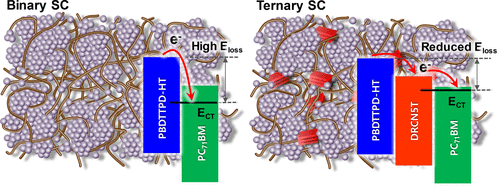当前位置:
X-MOL 学术
›
ACS Appl. Energy Mater.
›
论文详情
Our official English website, www.x-mol.net, welcomes your feedback! (Note: you will need to create a separate account there.)
Elimination of Charge Transfer Energy Loss by Introducing a Small-Molecule Secondary Donor into Fullerene-Based Polymer Solar Cells
ACS Applied Energy Materials ( IF 6.4 ) Pub Date : 2020-07-10 , DOI: 10.1021/acsaem.0c01000 Do Hui Kim 1 , Jiho Ryu 1 , Febrian Tri Adhi Wibowo 2 , Song Yi Park 2 , Jin Young Kim 2 , Sung-Yeon Jang 2 , Shinuk Cho 1
ACS Applied Energy Materials ( IF 6.4 ) Pub Date : 2020-07-10 , DOI: 10.1021/acsaem.0c01000 Do Hui Kim 1 , Jiho Ryu 1 , Febrian Tri Adhi Wibowo 2 , Song Yi Park 2 , Jin Young Kim 2 , Sung-Yeon Jang 2 , Shinuk Cho 1
Affiliation

|
The fullerene acceptor, which has historically been used in bulk-heterojunction (BHJ) organic solar cells, is being replaced by non-fullerene acceptors due to its problem of high energy loss (Eloss). To reduce the energy loss in BHJ organic solar cells as a means to improve open-circuit voltage (Voc), several approaches have been applied to diminish recombination loss, notably enhancements to film morphology and decreasing of trap states by improving the crystallinity of active components. However, the adjustment of trap density by means of morphology control only has an inevitable limit. In this work, we have investigated the use of a ternary configuration as an alternative way to mitigate the energy loss in fullerene-based BHJ solar cells. A ternary system based on the wide-band-gap polymer PBDTTPD-HT, the small molecule DRCN5T, and PC71BM showed cascading charge transfer from PBDTTPD-HT through DRCN5T to PC71BM, an indirect electron transfer that avoided the deep charge transfer state between PBDTTPD-HT and PC71BM. DRCN5T:PC71BM mixture has a high ECT level close to the singlet state energy of DRCN5T, leading to low energy loss between DRCN5T and PC71BM and thereby greatly reducing the probability of first-order recombination. Consequently, the incorporation of a small amount of DRCN5T as a secondary donor into the PBDTTPD-HT:PC71BM system enhanced overall PCE, an effect mostly attributed to enhancement of Voc by means of eliminating charge transfer energy losses.
中文翻译:

通过向基于富勒烯的聚合物太阳能电池中引入小分子次级供体,消除电荷转移能量损失
富勒烯受体由于其高能量损失(E损失)的问题,一直以来被用于体-异质结(BHJ)有机太阳能电池,现在正被非富勒烯受体取代。减少BHJ有机太阳能电池的能量损耗,以提高开路电压(V oc),已经采用了几种方法来减少重组损失,特别是通过改善活性成分的结晶度来增强膜的形态并降低陷阱态。然而,通过形态控制来调节阱密度仅具有不可避免的极限。在这项工作中,我们研究了使用三元构型作为减轻富勒烯基BHJ太阳能电池能量损失的替代方法。基于宽带隙聚合物PBDTTPD-HT,小分子DRCN5T和PC 71 BM的三元体系显示了电荷从PBDTTPD-HT通过DRCN5T到PC 71 BM的级联转移,间接电子转移避免了深电荷转移PBDTTPD-HT和PC 71 BM之间的状态。DRCN5T:PC 71BM混合物的高E CT水平接近DRCN5T的单重态能量,从而导致DRCN5T和PC 71 BM之间的能量损失低,从而大大降低了一阶重组的可能性。因此,将少量DRCN5T作为次级供体并入PBDTTPD-HT:PC 71 BM系统中可增强总体PCE,这主要归因于通过消除电荷转移能量损失而提高了V oc。
更新日期:2020-07-10
中文翻译:

通过向基于富勒烯的聚合物太阳能电池中引入小分子次级供体,消除电荷转移能量损失
富勒烯受体由于其高能量损失(E损失)的问题,一直以来被用于体-异质结(BHJ)有机太阳能电池,现在正被非富勒烯受体取代。减少BHJ有机太阳能电池的能量损耗,以提高开路电压(V oc),已经采用了几种方法来减少重组损失,特别是通过改善活性成分的结晶度来增强膜的形态并降低陷阱态。然而,通过形态控制来调节阱密度仅具有不可避免的极限。在这项工作中,我们研究了使用三元构型作为减轻富勒烯基BHJ太阳能电池能量损失的替代方法。基于宽带隙聚合物PBDTTPD-HT,小分子DRCN5T和PC 71 BM的三元体系显示了电荷从PBDTTPD-HT通过DRCN5T到PC 71 BM的级联转移,间接电子转移避免了深电荷转移PBDTTPD-HT和PC 71 BM之间的状态。DRCN5T:PC 71BM混合物的高E CT水平接近DRCN5T的单重态能量,从而导致DRCN5T和PC 71 BM之间的能量损失低,从而大大降低了一阶重组的可能性。因此,将少量DRCN5T作为次级供体并入PBDTTPD-HT:PC 71 BM系统中可增强总体PCE,这主要归因于通过消除电荷转移能量损失而提高了V oc。


























 京公网安备 11010802027423号
京公网安备 11010802027423号